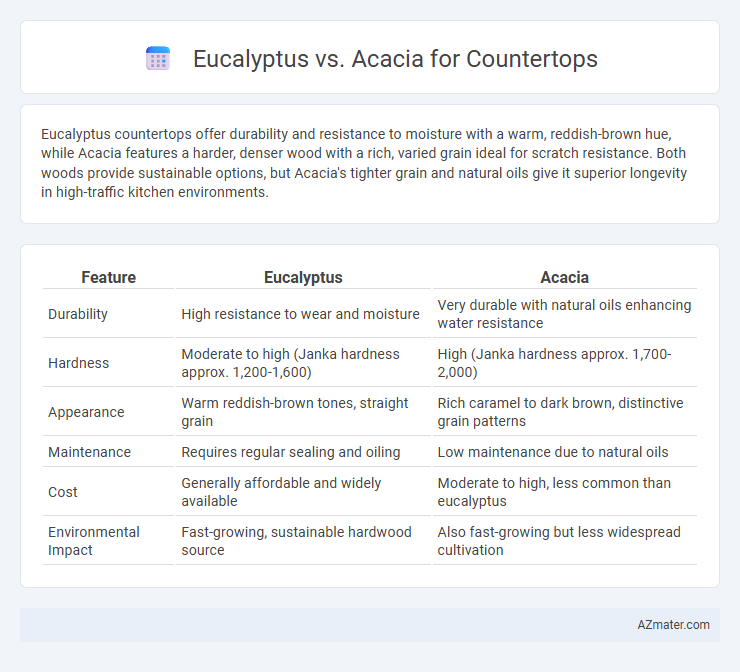Eucalyptus countertops offer durability and resistance to moisture with a warm, reddish-brown hue, while Acacia features a harder, denser wood with a rich, varied grain ideal for scratch resistance. Both woods provide sustainable options, but Acacia's tighter grain and natural oils give it superior longevity in high-traffic kitchen environments.
Table of Comparison
| Feature | Eucalyptus | Acacia |
|---|---|---|
| Durability | High resistance to wear and moisture | Very durable with natural oils enhancing water resistance |
| Hardness | Moderate to high (Janka hardness approx. 1,200-1,600) | High (Janka hardness approx. 1,700-2,000) |
| Appearance | Warm reddish-brown tones, straight grain | Rich caramel to dark brown, distinctive grain patterns |
| Maintenance | Requires regular sealing and oiling | Low maintenance due to natural oils |
| Cost | Generally affordable and widely available | Moderate to high, less common than eucalyptus |
| Environmental Impact | Fast-growing, sustainable hardwood source | Also fast-growing but less widespread cultivation |
Introduction: Eucalyptus vs Acacia Countertops
Eucalyptus and Acacia countertops offer distinct advantages in durability and aesthetic appeal, with Eucalyptus known for its uniform grain and resistance to moisture, making it ideal for kitchen environments. Acacia features rich, varied tones and natural hardness, providing a striking, resilient surface for high-traffic areas. Both hardwoods balance functionality with beauty, but Eucalyptus tends to be more sustainable due to its rapid growth rate.
Material Overview: Eucalyptus and Acacia Wood
Eucalyptus wood offers a dense, durable material with a fine, uniform grain, making it resistant to moisture and suitable for kitchen countertops. Acacia wood features a rich, varied grain pattern and exceptional hardness, providing both aesthetic appeal and strong wear resistance for heavy-use surfaces. Both woods are sustainably sourced hardwoods prized for their durability and natural resistance to scratches and stains in countertop applications.
Aesthetic Appeal and Grain Patterns
Eucalyptus countertops showcase a smooth, consistent grain with warm, amber tones that enhance modern and rustic kitchen designs. Acacia features a strikingly varied grain pattern with rich, contrasting hues ranging from light amber to deep chocolate brown, offering a bold and dynamic aesthetic. Both hardwoods provide durability, but Acacia's dramatic grain patterns create a more visually impactful statement compared to Eucalyptus's subtle elegance.
Durability and Hardness Comparison
Eucalyptus countertops offer excellent durability with a Janka hardness rating around 1,550, making them resistant to dents and scratches in high-traffic kitchen areas. Acacia wood exhibits higher hardness, typically rated between 1,700 and 1,900 on the Janka scale, providing superior resistance to impact and wear over time. Both woods are naturally dense and durable, but Acacia's greater hardness makes it more suitable for heavy-use countertops where long-term resilience is critical.
Water Resistance and Moisture Tolerance
Eucalyptus wood offers superior water resistance and moisture tolerance compared to Acacia, making it more suitable for countertops in high-humidity environments. Its dense grain structure provides better protection against warping and swelling caused by water exposure. While Acacia is durable and visually appealing, it requires more frequent sealing to maintain moisture resistance.
Maintenance Requirements and Longevity
Eucalyptus countertops require regular sealing and occasional oiling to maintain their durability and resistance to moisture, with typical longevity around 10-15 years under proper care. Acacia wood offers superior natural resistance to scratches and water damage, demanding less frequent maintenance and often lasting 15-20 years in kitchen environments. Both hardwoods benefit from routine cleaning and avoiding prolonged water exposure to maximize lifespan and aesthetic appeal.
Sustainability and Eco-Friendliness
Eucalyptus countertops are highly sustainable due to the fast growth rate and efficient carbon sequestration of eucalyptus trees, making them an eco-friendly choice for reducing environmental impact. Acacia wood is also sustainable, valued for its durability and natural resistance to pests, with many species sourced from responsibly managed plantations that support forest regeneration. Choosing eucalyptus or acacia for countertops supports eco-conscious decisions by utilizing renewable materials with low environmental footprints and promoting responsible forestry practices.
Cost and Availability in the Market
Eucalyptus countertops typically offer a lower cost compared to Acacia, making them a budget-friendly choice for many homeowners. Eucalyptus is also more readily available in North American markets due to faster growth rates and sustainable harvesting practices. Acacia, while durable and attractive, tends to be pricier and less abundant, often sourced from limited regions, impacting both price and accessibility.
Best Applications: Kitchen, Bathroom, and More
Eucalyptus countertops offer superior resistance to moisture and bacterial growth, making them ideal for kitchen and bathroom environments where hygiene is essential. Acacia provides exceptional durability and rich, warm tones that enhance aesthetic appeal in high-traffic areas like kitchen islands and bathroom vanities. Both woods respond well to proper sealing, but eucalyptus is preferred for wet areas due to its natural oil content, while acacia excels in adding a rustic charm to varied interior designs.
Final Verdict: Which Wood is Better for Countertops?
Eucalyptus offers superior durability and resistance to moisture, making it a reliable choice for kitchen countertops exposed to spills and humidity. Acacia provides a rich, warm aesthetic with natural resistance to scratches, but may require more maintenance over time to prevent wear. For long-lasting performance and minimal upkeep, eucalyptus is generally the better wood for countertops.

Infographic: Eucalyptus vs Acacia for Countertop
 azmater.com
azmater.com